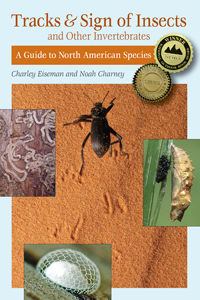I’m home from a great weekend at the Nantucket Biodiversity Research Conference, and now back to the business of sorting through my photos from this spring in Florida. This snazzy Oak Treehopper (Platycotis vittata) looks like the sort of thing you would only find in Florida, but in fact it occurs as far north as Pennsylvania in the east and British Columbia in the west. I found it on March 29, under an oak tree a bit north of Lake Okeechobee.
-
Join 1,126 other subscribers

-
If you enjoy reading this blog, please consider making a donation. I would devote all my time to natural history writing and photography if I could! You can make a one-time donation using the yellow button above, or click the “Become a Patron” button to learn how you can support my work on a monthly basis, which gets you (among other things) monthly installments of my new leafminer book. To see other options for getting the book, click the image of its cover below.



-
To order either of my books, click on the images of their covers above.
-
Recent Posts
Do you know your plants?
For my Leafminers of North America project, I periodically need help identifying hostplants I find in my travels. You can peruse photos of them at iNaturalist. Thanks!
Most Used Tags
- Agromyzidae
- ant
- Arizona
- Asteraceae
- bee
- beetle
- Betulaceae
- black cherry
- Braconidae
- Bucculatrix
- butterfly
- caterpillar
- Cecidomyiidae
- chalcid
- cherry
- Chrysomelidae
- cocoon
- Coleoptera
- Curculionidae
- Curculionoidea
- Cynipidae
- Diptera
- egg
- Eulophidae
- Fabaceae
- Fagaceae
- flower
- fly
- Formicidae
- fungus
- gall
- gall midge
- gall wasp
- Gelechiidae
- goldenrod
- Gracillariidae
- Hymenoptera
- Ichneumonidae
- ichneumon wasp
- jumping spider
- larva
- leaf mine
- leafminer
- Lepidoptera
- midge
- moth
- Nantucket
- Nepticulidae
- new species
- oak
- parasitism
- parasitoid
- Phyllonorycter
- Phytomyza
- Platygastridae
- predation
- Prunus
- Prunus serotina
- Pteromalidae
- pupa
- puparium
- Quercus
- Quercus rubra
- red oak
- Rosaceae
- Salicaceae
- Salticidae
- sawfly
- spider
- springtail
- Stigmella
- Tenthredinidae
- Tortricidae
- wasp
- weevil
Categories
Top Posts & Pages
Bug Links
Blogroll
Archives
- April 2024
- March 2024
- February 2024
- November 2023
- June 2023
- April 2023
- February 2023
- November 2022
- October 2022
- August 2022
- July 2022
- March 2022
- February 2022
- January 2022
- December 2021
- November 2021
- June 2021
- March 2021
- February 2021
- December 2020
- November 2020
- October 2020
- September 2020
- August 2020
- July 2020
- June 2020
- May 2020
- April 2020
- March 2020
- February 2020
- January 2020
- December 2019
- November 2019
- October 2019
- September 2019
- August 2019
- June 2019
- May 2019
- April 2019
- March 2019
- February 2019
- January 2019
- December 2018
- November 2018
- September 2018
- August 2018
- June 2018
- May 2018
- April 2018
- December 2017
- November 2017
- October 2017
- September 2017
- August 2017
- July 2017
- May 2017
- April 2017
- March 2017
- January 2017
- December 2016
- November 2016
- October 2016
- September 2016
- August 2016
- July 2016
- June 2016
- May 2016
- April 2016
- March 2016
- February 2016
- January 2016
- December 2015
- November 2015
- October 2015
- September 2015
- August 2015
- May 2015
- April 2015
- March 2015
- February 2015
- January 2015
- December 2014
- November 2014
- October 2014
- September 2014
- August 2014
- July 2014
- June 2014
- May 2014
- April 2014
- March 2014
- February 2014
- January 2014
- December 2013
- November 2013
- October 2013
- September 2013
- August 2013
- July 2013
- June 2013
- May 2013
- April 2013
- March 2013
- February 2013
- January 2013
- December 2012
- November 2012
- October 2012
- September 2012
- August 2012
- July 2012
- June 2012
- May 2012
- April 2012
- March 2012
- February 2012
- January 2012
- December 2011
- November 2011
- October 2011
- September 2011
- August 2011
- July 2011
- June 2011
- May 2011
- April 2011
- March 2011
Meta


What a lovely little bug!
Is this species the same size as other leaf hoppers? Seems to have a higher profile. Great pic, as usual. Do you pay them to hold still?
This is a typical sized treehopper (a little larger than the average leafhopper), about 12 mm from the tip of the “horn” to the wingtip. Most bugs I want to photograph don’t cooperate too well, but every once in a while I meet one like this that is willing to hold still until I get it right!
Reblogged this on timEBush.com and commented:
inspiring!
Since you found it on my birthday, I’ll think of it as a gift. ; )
The nymphs of the oak leafhopper are so cool…they look like something out of Star Wars!
Too bad we do not have them here in the Midwest.
Ever considered videotaping these incredible creatures?
Sometimes! There was a gracillariine moth that emerged from a leaf collected on this trip that I really wish I could have caught on video. When at rest, it was constantly rocking from side to side, at the same time swiveling its extremely long antennae in circles. I would have to upgrade my camera to do this though; I don’t currently have anything capable of recording video.